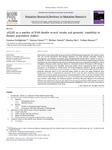Mostrar o rexistro simple do ítem
γH2AX as a Marker of DNA Double Strand Breaks and Genomic Instability in Human Population Studies [Review]
| dc.contributor.author | Valdiglesias, Vanessa | |
| dc.contributor.author | Giunta, Simona | |
| dc.contributor.author | Fenech, M. | |
| dc.contributor.author | Neri, Monica | |
| dc.contributor.author | Bonassi, Stefano | |
| dc.date.accessioned | 2024-04-22T14:11:19Z | |
| dc.date.issued | 2013-02-13 | |
| dc.identifier.citation | Vanessa Valdiglesias, Simona Giunta, Michael Fenech, Monica Neri, Stefano Bonassi, γH2AX as a marker of DNA double strand breaks and genomic instability in human population studies, Mutation Research/Reviews in Mutation Research, Volume 753, Issue 1, 2013, Pages 24-40, ISSN 1383-5742, https://doi.org/10.1016/j.mrrev.2013.02.001. (https://www.sciencedirect.com/science/article/pii/S1383574213000239) | es_ES |
| dc.identifier.issn | 1383-5742 | |
| dc.identifier.uri | http://hdl.handle.net/2183/36293 | |
| dc.description.abstract | [Abstract] DNA double strand breaks (DSB) are the gravest form of DNA damage in eukaryotic cells. Failure to detect DSB and activate appropriate DNA damage responses can cause genomic instability, leading to tumorigenesis and possibly accelerated aging. Phosphorylated histone H2AX (γH2AX) is used as a biomarker of cellular response to DSB and its potential for monitoring DNA damage and repair in human populations has been explored in this review. A systematic search was conducted in PubMed for articles, in English, on human studies reporting γH2AX as a biomarker of either DNA repair or DNA damage. A total of 68 publications were identified. Thirty-four studies (50.0%) evaluated the effect of medical procedures or treatments on γH2AX levels; 20 (29.4%) monitored γH2AX in specific pathological conditions with a case/control or case/case design; 5 studies (7.4%) evaluated the effect of environmental genotoxic exposures, and 9 (13.2%) were descriptive studies on cancer and aging. Peripheral blood lymphocytes (44.6%) or biopsies/tissue specimens (24.3%) were the most commonly used samples. γH2AX was scored by optical microscopy as immunostained foci (78%), or by flow cytometry (16%). Critical features affecting the reliability of the assay, including protocols heterogeneity, specimen, cell cycle, kinetics, study design, and statistical analysis, are hereby discussed. Because of its sensitivity, efficiency and mechanistic relevance, the γH2AX assay has great potential as a DNA damage biomarker; however, the technical and epidemiological heterogeneity highlighted in this review infer a necessity for experimental standardization of the assay. | es_ES |
| dc.description.sponsorship | The study was supported by grants funded by the AIRC (Associazione Italiana per la Ricerca sul Cancro) [SB, VV], and INAIL (Istituto Nazionale Assicurazione contro gli Infortuni sul Lavoro) [SB, MN]. SG was supported by an International Cancer Technology Transfer (ICRETT) Fellowship from the Union for International Cancer Control (UICC). | es_ES |
| dc.language.iso | eng | es_ES |
| dc.publisher | Elsevier | es_ES |
| dc.relation.uri | https://doi.org/10.1016/j.mrrev.2013.02.001 | es_ES |
| dc.rights | © 2013 Elsevier B.V. All rights reserved. | es_ES |
| dc.subject | γH2AX | es_ES |
| dc.subject | DNA double strand breaks | es_ES |
| dc.subject | Genomic instability | es_ES |
| dc.subject | Human population studies | es_ES |
| dc.subject | Molecular epidemiology | es_ES |
| dc.title | γH2AX as a Marker of DNA Double Strand Breaks and Genomic Instability in Human Population Studies [Review] | es_ES |
| dc.type | info:eu-repo/semantics/article | es_ES |
| dc.rights.access | info:eu-repo/semantics/embargoedAccess | es_ES |
| dc.date.embargoEndDate | 9999-99-99 | es_ES |
| dc.date.embargoLift | 10007-06-07 | |
| UDC.journalTitle | Mutation Research/Reviews in Mutation Research | es_ES |
| UDC.volume | 753 (2013) | es_ES |
| UDC.issue | 1 | es_ES |
| UDC.startPage | 24 | es_ES |
| UDC.endPage | 40 | es_ES |
| dc.identifier.doi | 10.1016/j.mrrev.2013.02.001 |






